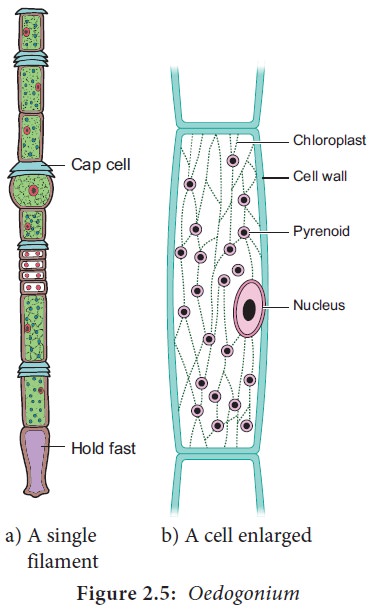Chapter: 11th Botany : Chapter 2 : Plant Kingdom
Oedogonium - Algae

Oedogonium
Class – Chlorophyceae
Order - Oedogoniales
Family -Oedogoniaceae
Genus – Oedogonium
Oedogonium
is a freshwater
, filamentous alga and occurs in
ponds, lakes and stagnant water. The filaments are attached to rocks. Some are
epiphytic on aquatic plants. Oedogonium
terrestre is a terrestrial form and grow in moist soils. The young
filaments are attached but older ones are free floating.
Thallus structure
The thallus is filamentous ,multicellular and
unbranched. All the cells of the filament are cylindrical except the basal and
apical cell. The basal cell is colourless and forms hold fast. The proximal end
of the hold fast extends to produce finger like projections which help the
filament to attach on the substratum. The apical cell is rounded or elongated
in shape. Each vegetative cell is cylindrical and possesses a thick cell wall.
The inner layer is cellulosic and the outer layer is made up of pectin. A thin
layer of chitin is present above the pectin layer. Next to the cell wall a
plasma membrane is present. A large vacuole is present. The protoplasm contains
reticulate chloroplast and it extends from one end of the cell to the other. A
single nucleus and many pyrenoids are present. The distal end of some cells
possess ring like markings called apical caps. Such cells are called cap cells.
The presence of cap cell is characteristic feature of Oedogonium (Figure 2.5).

Reproduction
Oedogonium
reproduces
by vegetative, asexual and sexual
methods. Vegetative reproduction takes place by fragmentation and akinete
formation. During asexual reproduction zoospores are formed. During favourable
conditions, some of the vegetative cells function as zoosporangia. Usually a
single zoospore is produced per zoosporangium. A ring of short flagella is
found at the base of colourless, beak like anterior end of the zoospore. This
kind of flagellation is called stephanokont. The zoospore is released from the
zoosporangium and swims in water (Figure 2.6). If it reaches a suitable
substratum, it divides into two cells. The lower cell forms holdfast. The green
upper cell divides and produces the filament.


Figure
2.6: Reproduction in Oedogonium
Sexual reproduction is Oogamous. The male
gametangium is antheridium and female gametangium is called Oogonium. Based on
the distribution of sex organs there are two types of species namely
Macrandrous and Nannandrous.
Macrandrous monoecious – Antheridia and Oogonia
occur on same filament – Oedogonium
fragile.
Macrandrous dioecious – Antheridia and Oogonia
occur on separate filaments – Oedogonium
crassum
In nannadrous species antheridia are produced on
reduced male filaments called dwarf male plants(O.cancatenatum).
In nannandrous species antheridia develop on
specialised 2–4 celled filaments called dwarf males. The dwarf male is
developed from androspores released from the androsporangium.. If the
androsporangia and oogonia develop on same filament, it is called gynandrosporous (O. concatenatum ). If they are borne on different filaments
it is called idioandrosporous (O. conferatum). The antheridium produces
multiflagellate antherozoids. They are released by transverse splitting of the
wall of antheridium. Antherozoids are attracted chemotactically towards the
mature oogonium. A single antherozoid enters the oogonium through the opening
present on the wall of the oogonium. The male nucleus fuses with the egg to
form a diploid zygote. After fertilization the zygote separates from the
oogonial wall and a thick wall is secreted around it. The diploid zygote
undergoes meiosis to produce 4 haploid multiflagellate zoospores. The wall of
the zygote ruptures to release the zoospores.The germination of the zoospore
produces haploid filaments of Oedogonium
(Figure 2.6).
In the life cycle of Oedogonium the diploid phase is short lived and is represented by
zygote. The haploid phase is predominant and life cycle is of Haplontic type (Figure 2.7).

Related Topics